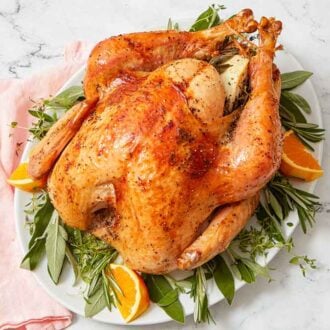
How to Cook A Turkey
Roast the most delicious, juicy turkey with this guide on how to cook a turkey. You’ll love the crispy skin and abundance of flavor that comes with a simple seasoned butter and the right technique!
Servings 10 to 12 servings
Calories 630kcal
Equipment
- Roasting pan with rack
- mixing bowl
- Basting or pastry brush
- Aluminum foil (if needed)
Ingredients
- 1 (10-12-pound) fresh turkey thawed if frozen*
- 1 cup unsalted butter room temperature (227g)
- 2 teaspoons salt
- 1½ teaspoons ground black pepper
- 1 onion peeled and quartered
- 10 to 12 rosemary sprigs
- 10 to 12 thyme sprigs
- 10 to 12 sage sprigs
- 1 head garlic halved
- 4 cups chicken broth (960ml)
Instructions
- Remove all packaging and place the turkey breast side up in a large roasting pan with a wire rack. If brining your turkey, let the turkey drain well before placing it in the pan. Remove any giblets in the turkey cavity. Pat the turkey dry all over with paper towels. Let sit uncovered at room temperature for 1 hour. (This will help dry out the skin for better browning and take the chill off the turkey.)
- After an hour, preheat the oven to 450F.
- In a medium mixing bowl, stir together the butter, salt, and black pepper.
- Stuff the cavity with the onion, garlic, 8 sprigs of rosemary, and 8 sprigs of sage. Place the remaining herb sprigs in the roasting pan around the turkey.
- For better presentation, tie the legs together with kitchen twine.
- Rub the butter mixture all over the turkey, making sure to get under the skin on the breast and legs. Pour the stock into the roasting pan.
- Place the turkey in the oven and roast for 15 minutes. Reduce the oven temperature to 325F. Continue roasting, basting the turkey every 30 minutes with the pan juices, until a meat thermometer inserted into the thickest portion of the thigh registers 165F, 2 to 2½ hours or about 12 minutes per pound of turkey. Add more broth or some water to the roasting pan if it starts to dry out at any point. If the breast area or leg or wingtips start to get too brown anytime during cooking, shield just those areas with foil.
- Let the turkey rest in the roasting pan for 15 minutes before carving. Strain the drippings in the roasting pan and serve with the turkey or use it to make a delicious, flavorful gravy.
Video
Notes
- Let the turkey sit at room temperature for 1 hour before roasting. This will help dry out the skin for better browning and take the chill off the turkey.
- Use different flavor combinations: The simplicity of the turkey seasoning shouldn’t be underestimated! The butter, salt, pepper, and bunches of aromatics create a wonderfully juicy and flavorful turkey. If you’re feeling more adventurous, use your favorite spice blend or make a homemade turkey seasoning rub, and mix it into the softened butter. Cajun seasoning or a garlicky Greek seasoning are two of my favorites. Have fun with the flavors!
- If I plan to make a gravy with the drippings, I like to slice up an extra onion, carrots, celery, an apple, or whole lemon and place it in the bottom of the roasting pan before adding the turkey, infusing the pan drippings with even more flavor.
- Start the oven at a high temperature. Starting the turkey at a higher oven temperature essentially “sears” the outside, creating a more crispy golden skin during roasting while also helping to seal in the juices so the turkey stays moist during the long cooking time.
- Baste the turkey: Continuously basting the turkey keeps the outside from getting too dry and also helps brown the skin for a moist turkey, so I definitely wouldn’t skip that step! I use a pastry brush dipped in the pan juices to brush over the bird. There is no need for a baster if you don’t have one.
- If the breast area or leg or wingtips start to get too brown during cooking, shield just those areas with aluminum foil.
- Let the turkey rest for at least 15 minutes before carving. This is a vital step so the juices in the turkey can redistribute, so that every bite is juicy and moist. If you carve the turkey immediately, the juices will run out onto your cutting board.
Nutrition
Calories: 630kcal | Carbohydrates: 2g | Protein: 71g | Fat: 37g | Saturated Fat: 16g | Polyunsaturated Fat: 5g | Monounsaturated Fat: 11g | Trans Fat: 1g | Cholesterol: 283mg | Sodium: 1178mg | Potassium: 778mg | Fiber: 1g | Sugar: 1g | Vitamin A: 828IU | Vitamin C: 3mg | Calcium: 57mg | Iron: 3mg